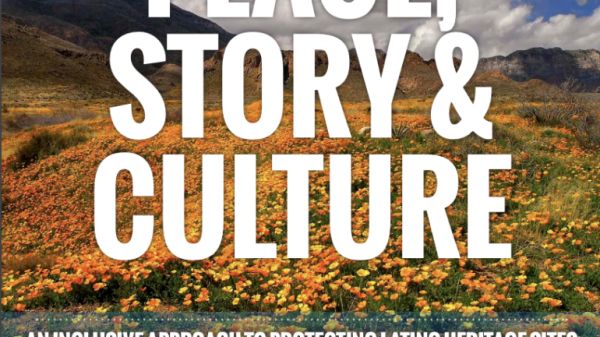Place, Story, and Culture: An Inclusive Approach to Protecting Latino Heritage Sites

Published by the Hispanic Access Foundation in July 2021, this report explores places in the United States that embody the architectural, cultural and deep historical roots of the Latino community and provides recommendations to address the lack of representation of Latino heritage sites among protected area designations, by proposing a more inclusive designation system as well as a list of Latino heritage sites that currently lack official recognition.
Featured sites include:
#1: Castner Range (Texas)
In the heart of El Paso, Texas, Castner Range provides a solid backdrop to the burgeoning city, which has grown around the range and has embraced it as a feature of the landscape. Castner Range has been the ancestral home to the Comanche and Apache people, and various Indigenous communities continue to view the range as sacred.
#2: Chepa’s Park (California)
Located in the Logan Barrio neighborhood of Santa Ana, California’s oldest Mexican American neighborhood, Chepa’s Park is more than a site for recreational activities—it is a landmark serving as a testament to the legacy of community leader Josephina “Chepa” Andrade.
#3: Duranguito (Texas)
Downtown El Paso has a neighborhood called “Duranguito,” named after Durango Street on its western side, with a unique and storied history. It is the oldest neighborhood in the city, from its beginnings as a conversion site of Spanish colonizers to its "zona libre" period during the U.S.-Mexico War to its continued binational, multiethnic community.
#4: Fefa’s Market (Rhode Island)
Fefa’s Market in Providence is a notable site to the Latino community in Rhode Island. In the mid-1960s Josefina Rosario opened what became the first Dominican-owned bodega on Broad Street. Rosario, recognized by her nickname “Dona Fefa,” became instrumental in the growth and evolution of the Dominican community that sprawled in Providence.
#5: Friendship Park (California)
Located at the southwestern edge of the United States and the northwestern corner of Latin America, Friendship Park is not only a significant place to the history of the United States but is necessary to transborder cultural connectivity between San Diego, California, and Tijuana, Mexico.
#6: Gila River (New Mexico)
The Gila River system is a valuable resource to all New Mexicans in that it provides a beautiful natural landscape to be enjoyed and appreciated by people from all over, a necessary environment for wildlife to thrive, an important window into the history of New Mexico, a significant agricultural resource, and an important place to further the study of our natural environment.
#7: Hazard Park (California)
Hazard Park is an important historical site contributing to one of the most significant youth-led Chicano social movements, the 1968 East Los Angeles Blowouts. It is also among the few green public spaces in East Los Angeles, on which generations of families have depended for relaxation and recreation.

